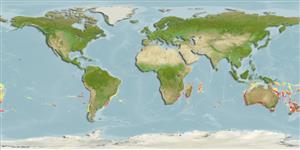>
Scombriformes (Mackerels) >
Trichiuridae (Cutlassfishes) > Aphanopodinae
Etymology: Benthodesmus: Greek, benthos = depth of the sea + Greek, desmos = bond, chain (Ref. 45335).
Environment: milieu / climate zone / depth range / distribution range
Ecologia
marino benthopelagico; distribuzione batimetrica 178 - 950 m (Ref. 6181). Deep-water; 9°S - 44°S, 30°E - 26°W (Ref. 6181)
Atlantic, Indian and Pacific: off south Brazil and Argentina, Rio Grande Rise, southeastern Africa, Madagascar Ridge, southeastern Australia, New Zealand, Sala y Gomez Ridge.
Length at first maturity / Size / Peso / Age
Maturity: Lm ?, range 57 - ? cm
Max length : 100.0 cm TL maschio/sesso non determinato; (Ref. 9351)
Short description
Morfologia | Morfometria
Spine dorsali (totale): 42 - 46; Raggi dorsali molli (totale): 99-108; Spine anali 2; Raggi anali molli: 91 - 98; Vertebre: 151 - 159. Body silvery, jaws and opercle blackish. The inside of the mouth and gill cavities black.
Juveniles mesopelagic (Ref. 6181); also benthopelagic (Ref. 5951). Feeds on crustaceans (mainly prawns and euphausiids), small fishes (e.g. Maurolicus) and squid (Ref. 6202). Minimum depth reported from Ref. 36453.
Life cycle and mating behavior
Maturità | Riproduzione | Deposizione | Uova | Fecundity | Larve
Batch spawners with 5,000 to 16,000 eggs per spawn.
Nakamura, I. and N.V. Parin, 1993. FAO Species Catalogue. Vol. 15. Snake mackerels and cutlassfishes of the world (families Gempylidae and Trichiuridae). An annotated and illustrated catalogue of the snake mackerels, snoeks, escolars, gemfishes, sackfishes, domine, oilfish, cutlassfishes,. scabbardfishes, hairtails, and frostfishes known to date. FAO Fish. Synop. 125(15):136 p. (Ref. 6181)
IUCN Red List Status (Ref. 130435)
Threat to humans
Harmless
Human uses
Informazioni ulteriori
Age/SizeAccrescimentoLength-weightLength-lengthLength-frequenciesMorfometriaMorfologiaLarveDinamica popolazioni larvaliReclutamentoAbbondanzaBRUVS
BibliografiaAcquacolturaProfilo di acquacolturaVarietàGeneticaElectrophoresesEreditarietàMalattieElaborazioneNutrientsMass conversion
Strumenti
Special reports
Download XML
Fonti Internet
Estimates based on models
Preferred temperature (Ref.
123201): 8.9 - 17.1, mean 11.7 °C (based on 175 cells).
Phylogenetic diversity index (Ref.
82804): PD
50 = 0.5005 [Uniqueness, from 0.5 = low to 2.0 = high].
Bayesian length-weight: a=0.00014 (0.00008 - 0.00025), b=3.10 (2.93 - 3.27), in cm total length, based on LWR estimates for this species & (Sub)family-body (Ref.
93245).
Trophic level (Ref.
69278): 3.9 ±0.66 se; based on food items.
Resilienza (Ref.
120179): Basso, tempo minimo di raddoppiamento della popolazione 4.5 - 14 anni (tm=5-6).
Fishing Vulnerability (Ref.
59153): High vulnerability (60 of 100).
Nutrients (Ref.
124155): Calcium = 14.8 [6.8, 30.5] mg/100g; Iron = 0.302 [0.138, 0.677] mg/100g; Protein = 16.7 [15.0, 18.3] %; Omega3 = 0.232 [0.105, 0.515] g/100g; Selenium = 27.2 [10.9, 72.9] μg/100g; VitaminA = 15.2 [2.6, 81.5] μg/100g; Zinc = 0.362 [0.223, 0.599] mg/100g (wet weight);
